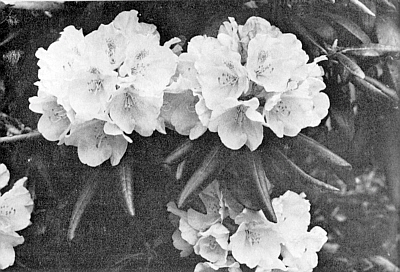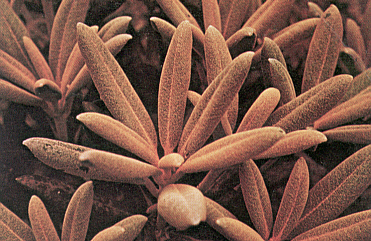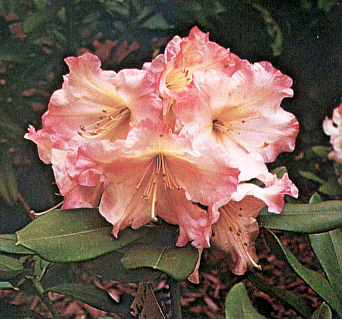Some Rh. yakushimanum Hybrids
C. H. Phetteplace, M.D.
(From a panel discussion on new hybrids at the 1972 Annual Meeting)

|
|
FIG. 55.
R. yakushimanum
'Mist Maiden'
A David Leach selection. C. Smith photo |
In exploring the gardens in the Eugene, Oregon, area, both commercial and amateur, problem soon became apparent as to how to give you much of a picture of what new hybrids we have you would care to know about.
Since nearly everyone growing rhododendrons does some playing about with pollen there are naturally a considerable number of new hybrids that arouse the hopes of the grower and often at first seem quite promising. Yet from experience we know that a very large portion of them will be disappointing as they are grown on in the years ahead.
The first slide is a good example. This was taken of Bob Commerford's cross of 'Leo' crossed with 'Mars', a deep red which took the grand prize for the best truss in the Show at the National Society annual meeting in Seattle in 1964. It was spectacular. Bob tells me now that he has never had a truss comparable to this from any plants of this cross since.
Perhaps we are not unique in our area that we have a considerable number of people working with
R. yakushimanum
. Most have ideas, goals or objectives in mind such as a perfect red or yellow
yakushimanum
, an even more striking indumentum; beauty plus great hardiness, heat tolerance and others. Though many of these hybrids have now been growing a number of years they are nonetheless about as new as one would care to pass judgment on just now. With the time allotted on this panel it would seem adequate for me to confine my remarks to these
yakushimanum
hybrids alone and show slides of just a few to give you some idea of the variety that has been produced and perhaps suggest some of the objectives motivating the hybridizers in this work.
To go back a bit, many of you will remember when
R. yakushimanum
was first introduced into England through Mr. K. Wada about 1940 there was some excitement expressed over the possibilities this species presented as a parent in breeding. Before long, however, we read notes of disappointment in the British literature and even noted criticism from some sources of anyone who would presume to defile this gem of perfection by hybridizing it with anything. Any such hybrid was certain to violate the first criterion of judging hybrids; namely, to be worthy it must be at least as good or better in some way than its parents.

|
|
R. yakushimanum
in new growth.
Photo by Cecil Smith |
Almost at once it was noted that on any of these hybrids the beautiful indumentum of
yakushimanum
was either lost or at best inferior. This indeed was a major disappointment since there are many who feel that the foliage and indumentum of
yakushimanum
is unexcelled by any other species known. Indeed there are an increasing number of growers who prize the beauty of the foliage well above that of any flowers the plant may have. This affords a year 'round source of enjoyment to them while the flowers are soon gone.
It must be accepted as obvious that no hybrid of
yakushimanum
has yet or ever will come forth which has the over-all beauty of the species itself.
But are
yakushimanum
hybrids exceptional in this respect? Kingdon-Ward has written in the little book titled "Rhododendrons" published by Latimer House Ltd. of London and I quote ". . .. except in the azalea group it is doubtful whether any hybrid superior to the parent species has ever been produced."
R. griffithianum
is another example of a species of almost unmatched beauty that has been so very widely used in hybridizing. Again it is unlikely that any of its progeny are as beautiful as the parent. Yet for over 100 years many of the most beautiful, widely grown and reliable garden hybrids have some
griffithianum
in their genetic background. And in this instance the parent itself is too tender to be of much garden value, despite its great beauty.
The reason for such extensive use of both these species in breeding seems to me to be very similar. Though we are clearly unable to match the beauty and perhaps even the quality of the parent in our hybridizing we are able by making use of certain qualities they impart to produce a great variety of very useful plants for general garden use.
R. yakushimanum
hybrids are especially useful, inasmuch as they generally do not overgrow the landscape and architecture of our modern homes, they are generally neat in habit, tend to flower at an early age and are attractive in flower. They offer a varied assortment to select from and are especially valuable because of their hardiness and adaptability. Bill Moynier of Los Angeles who has both excessive heat and alkaline water to contend with writes me that, so far, he has had better success with
yakushimanum
hybrids than any other varieties he has tried. At the same time in chilly Connecticut Dr. Serbin is most enthusiastic about them. They have tested out amazingly well in some of the coldest weather in the Midwest, as I will mention later.
I should like to proceed with the slides, but before doing so must give credit especially to Cecil Smith and Bob Commerford for supplying me with most of the slides. Both these men have been making these crosses and growing them for around 20 years.
I believe that a number of Bob's earliest plants were little seedlings from crosses Jock Brydon had made before he turned his nursery over to the Commerfords when he accepted the position with Strybing Arboretum here in San Francisco.
The slide here shown is the "Queen Mother"
yakushimanum
itself, the F.C.C. form grown and photographed by Cecil Smith. Indeed, one would be presumptuous to think he could produce a hybrid more beautiful than this. This plant is near ten years old. It is almost perfectly round, standing thirty inches tall, so compact that none of the skeletal structure of the shrub can be seen. The beautiful, well shaped white trusses are in perfect harmony with the neat bi-convex foliage and plant generally and should one fail to appreciate the foliage one may enjoy in this variety let us look at the next slide which shows the plant's new growth. Here the leaves are very heavily dusted with a cinnamon tomentum while at this stage the heavy fur-like indumentum is quite white. In due time from rain or overhead sprinkling the tomentum is washed off, by which time the thick indumentum has become a rich brown which persists and the upper surface becomes quite shiny.
Now to show you a few hybrids I have selected from scores the abovementioned men have loaned to me for this occasion. These have not necessarily been selected because they were outstanding but more to give you an idea of the range found in these crosses. The first is
yakushimanum
x 'Harvest Moon', a lovely, slightly ruffled white with just a touch of pink spotting in the throat. A plant of this won the Gold Cup for the best new American hybrid in flower at the Portland show a year ago.
Next,
yakushimanum
x 'Mrs. Betty Robertson' shows a fairly good quality of yellow with a nice flower and truss and considerable of the 'Mrs. Betty Robertson' throat markings persisting. Next is a sibling of the preceding, lacking the yellow but with a much more of the 'Mrs. Betty Robertson' blotch in the throat. This, oddly enough, appears quite pink before fully opened, then becomes nearly white in time but the blotch is unchanged.
We now see
yakushimanum
x 'Mars'. It is quite a bright pink with an unusually nice compact truss, but the intensity of pink fades out rather fast. I believe, however, this is one of Bob's favorites as the next slide will show a field of several hundred of this same hybrid, each plant covered with bloom, all growing in full sun and an impressive sight.
We now show
yakushimanum
x 'Purple Splendor'. This comes out a strong pink with very ruffled edges. It is a tight ball of truss with excellent foliage.
Next is
yakushimanum
x
ponticum
which is somewhat surprising to me. It is a shell pink with daintily ruffled edges, without blotch and a snug truss of many florets. Bob has sent many of these hybrids to regions of severe climates and reports that most are hardy in 15° below zero with wind at 45 m.p.h
Here we have
yakushimanum
x 'Tumalo.' 'Tumalo' is a James cross of 'Loderi King George' x a White
decorum
.
R. yakushimanum
crossed with this gives a pure white with a rather open flower and nice truss. It is abundantly floriferous.
The next several slides show some of Cecil Smith's work. He has made this cross of
yakushimanum
x
sutchuenense
var.
geraldi
. At first this seems an incredible combination, but Cecil is always thinking of indumentum. It is not at all strikingly out of proportion and as Cecil hoped it has a very good indumentum. The red blotch of
geraldi
is practically unimpaired and gives eye appeal to this pink flower and good truss.
Here we have ('Jalisco x
yakushimanum
) x
yakushimanum
. You can see a considerable amount of yellow which of course must come from its grandparent 'Jalisco.'
This is 'Pilgrim' x
yakushimanum
, not quite fully out yet but at this stage is a very nice pink.
Most of us would not think of using the big leafed rhododendrons with
yakushimanum
, but Cecil will try anything that might yield good indumentum. This is
rex
x ('Fabia' x
yakushimanum
). It is pink with much deeper candy stripes, a tight truss and of course good indumentum on the foliage.
We now have the opposite extreme in matching sizes. This is
yakushimanum
x
proteoides
- a very neat little thing with handsome heavily indumented foliage and neat white flowers.

|
|
('Fabia' x
yakushimanum
) x
aberconwayi
Photo by Cecil Smith |
Another search for indumentum and possibly a good red is this
yakushimanum
x
elliottii
. As is almost invariably the case with
yakushimanum
hybrids, regardless of how brilliant red the other parent is such as
elliottii
for example, the hybrid soon fades out to pale pink or near white. This is somewhat so with yellow and even the blue of 'Susan', for example, may show up in the
yakushimanum
hybrid. Red seems quite recessive. Now shown is a full plant in flower of 'Norman Gill' x
yakushimanum
. It is a lovely pink garden plant that would be admired anywhere.
('Fabia' x
yakushimanum
) x aberconwayi, a large pink rimmed flower changing to a soft yellow in the throat, quite different and attractive.
R. yakushimanum
x 'Noyo Chief' - the latter being a probable hybrid of the deep red handsome foliaged
zeylanicum
. This comes out the deepest red of any of these hybrids I've seen and is very handsome with this excellent foliage. But, alas, as intense as this red is, it soon fades out to a large extent.
The next is a sibling of the preceding showing the entire plant. One must admire the handsome truss, foliage, habit and flower but as you see here it is pink but even so a very beautiful truss.
The last slide is
haematodes
x
yakushimanum
made by Art Childers. It is nice in every way but the red is not even a very strong pink.
In conclusion it would seem that continued work with
yakushimanum
is desirable. This may in time contribute a great variety of the most useful hybrids for our gardens. Many possibilities are yet to be explored, especially in the F3 and F4 generations and back crossing. In judging these plants one should try to dismiss from his mind the picture of the pristine "Queen Mother" but rather judge the hybrid in comparison with other hybrids which are most commonly grown in people's gardens everywhere.